

Logic: Deductive and Inductive. Section 1.
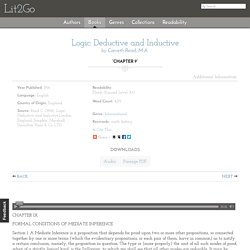
A Mediate Inference is a proposition that depends for proof upon two or more other propositions, so connected together by one or more terms (which the evidentiary propositions, or each pair of them, have in common) as to justify a certain conclusion, namely, the proposition in question. The type or (more properly) the unit of all such modes of proof, when of a strictly logical kind, is the Syllogism, to which we shall see that all other modes are reducible.
It may be exhibited symbolically thus: M is P; S is M .’. S is P. Logical Deduction Important Formulas - Logical Reasoning Questions and Answers. Logical Deduction: The phenomenon of deriving a conclusion from a single proposition or a set of given propositions, is known as logical deduction.
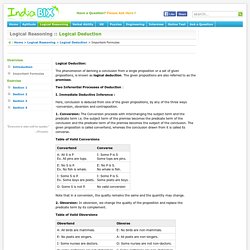
The given propositions are also referred to as the premises. Critical Wisdom - Deductive Reasoning. Introduction | Critical Thinking | Arguments | Deductive Reasoning | Inductive Reasoning | Fallacies | Language and Rhetoric | Writing and Speaking 4.
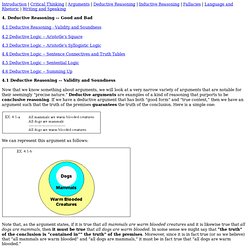
Deductive Reasoning -- Good and Bad 4.1 Deductive Reasoning - Validity and Soundness 4.2 Deductive Logic -- Aristotle’s Square 4.3 Deductive Logic -- Aristotle’s Syllogistic Logic. The Tree of Logic. By Nathaniel Bluedorn What do you study when you study “logic?”
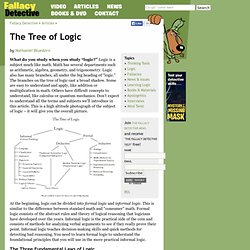
Logic is a subject much like math. Math has several departments such as arithmetic, algebra, geometry, and trigonometry. Logic also has many branches, all under the big heading of “logic.” Critical Wisdom - Deductive Reasoning. Clearer Thinking. Correct Thinking: Standard Categorical Format. Standard Categorical Format – translating ordinary language statements into categorical form.
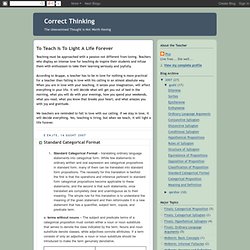
While few statements in ordinary written and oral expression are categorical propositions in standard form, many of them can be translated into standard form propositions. The necessity for this translation is twofold: the first is that the operations and inference pertinent to standard form categorical propositions become applicable to these statements, and the second is that such statements, once translated are completely clear and unambiguous as to their meaning. The simple rule for this translation is to understand the meaning of the given statement and then reformulate it in a new statement that has a quantifier, subject term, copula, and predicate term. a. terms without nouns – The subject and predicate terms of a categorical proposition must contain either a noun or noun substitute that serves to denote the class indicated by the term.
The word unless means if…not. CriticalThinking.org - Critical Thinking Model 1. To Analyze Thinking We Must Identify and Question its Elemental Structures Standard: Clarityunderstandable, the meaning can be grasped Could you elaborate further?
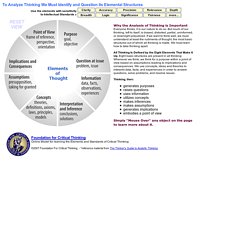
Could you give me an example? Could you illustrate what you mean? Standard: Accuracyfree from errors or distortions, true How could we check on that? Standard: Precisionexact to the necessary level of detail Could you be more specific? Standard: Relevancerelating to the matter at hand How does that relate to the problem? Critical Thinking Guide. Rhetological Fallacies. A brain-blending categorisation and visualisation of errors and manipulations of rhetoric and logical thinking.

How many do you use? The word ‘rhetological’ is made up. Just so I can munge two types of entity: rhetorical techniques and logical fallacies. Both are used heavily by institutional powers – governments, religions, political parties, across the entire spectrum to sway opinion, confuse and obfuscate. And, unfortunately, we internalise them, like bad habits, into our own decision-making and mental processes. Triangulations. In my “How to Reason and Argue” course (week 2 of 12 — still time to join), Walter (our professor) is setting out by defining terms.
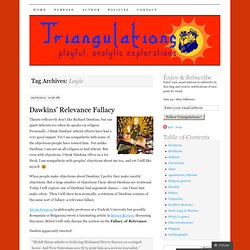
And indeed, agreed definitions are crucial for effective communication. “The beginning of wisdom, is the definition of terms.” –Socrates (quoted in my sidebar) Contrary to a common illusion, words do not have “fixed” definitions — see my “Myth of Definitions“. Instead, words have many varied uses and depend not only on context but also on the idiolect of the speaker. Walter wants us to agree on the word “argument“. Briefly, here are short definitions of the terms in his chart (no need to discuss them further, though): Linguistic Act: a meaningful utteranceSpeech Act: a linguistic act intended to bring about an effectConversation Act: a speech act that actually has a desired effectArguments: a certain type of conversation act.
Arguments have many uses. Argument Maps vs Other Argument Diagrams. I believe that argument maps as I understand them are superior to other types of argument diagrams.

I will describe four different kinds of argument diagrams, then explain why argument maps seem to be the best. Four different kinds of argument diagrams. Franklin Veaux's Journal - Still More on the Taxonomy of Logical Fallacies. Okay, here's the third (and, with luck, final) go-round.
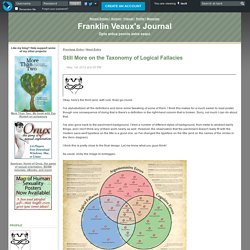
I've alphabetized all the definitions and done some tweaking of some of them. I think this makes for a much easier to read poster, though one consequence of doing that is there's a definition in the right-hand column that is broken. Sorry, not much I can do about that. I've also gone back to the parchment background.